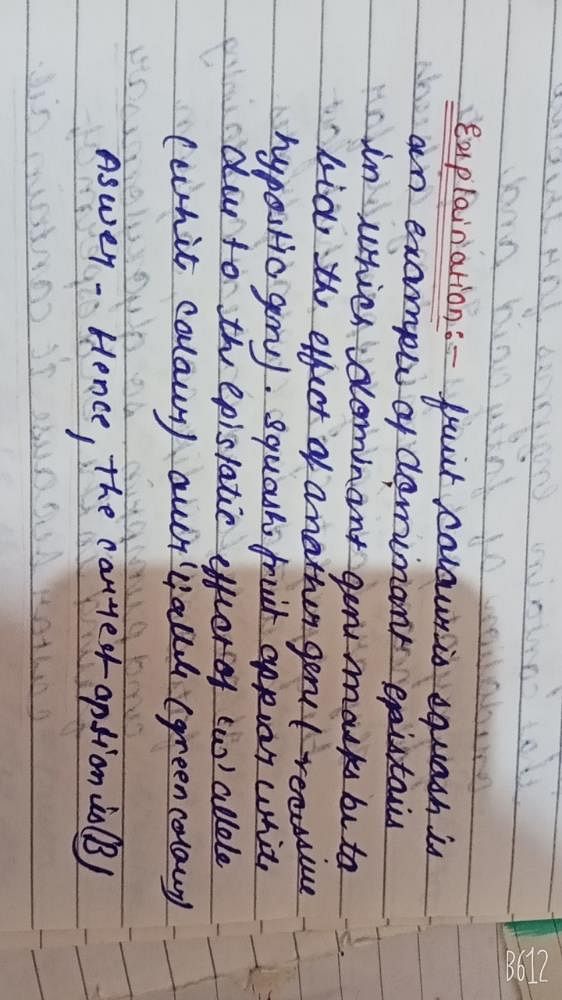NEET Exam > NEET Questions > Fruit colour in squash in an example of: ...
Start Learning for Free
Fruit colour in squash in an example of: [2014]
- a)Recessive epistasis
- b)Dominant epistasis
- c)Complementary genes
- d)Inhibitory genes
Correct answer is option 'B'. Can you explain this answer?
| FREE This question is part of | Download PDF Attempt this Test |
Verified Answer
Fruit colour in squash in an example of: [2014]a)Recessive epistas...
(b) Epistasis is the phenomenon of suppression of phenotypic expression of gene by a nonallelic gene which shows its own effect. A dominant epistatic allele suppresses the expression ofa nonallelic gene whether the latter is dominant or recessive. For example, fruit colour of Summer Squash (Cucurbita pepo) is governed by a gene which pruduces yellow colour in dominant state (Y-) and green colour in recessive state (yy).
Most Upvoted Answer
Fruit colour in squash in an example of: [2014]a)Recessive epistas...

Free Test
| FREE | Start Free Test |
Community Answer
Fruit colour in squash in an example of: [2014]a)Recessive epistas...
A dominant epistasis ia a condition when a dominant gene masks the effect of the other allelic or non-allelic gene.In summer squash,fruit colour may be white, yellow or green...So,dominant epistasis suppresses the expression of a non-allelic gene (dominant or recessive).Thus ...the correct option is B.
Attention NEET Students!
To make sure you are not studying endlessly, EduRev has designed NEET study material, with Structured Courses, Videos, & Test Series. Plus get personalized analysis, doubt solving and improvement plans to achieve a great score in NEET.

|
Explore Courses for NEET exam
|

|
Similar NEET Doubts
Fruit colour in squash in an example of: [2014]a)Recessive epistasisb)Dominant epistasisc)Complementary genesd)Inhibitory genesCorrect answer is option 'B'. Can you explain this answer?
Question Description
Fruit colour in squash in an example of: [2014]a)Recessive epistasisb)Dominant epistasisc)Complementary genesd)Inhibitory genesCorrect answer is option 'B'. Can you explain this answer? for NEET 2024 is part of NEET preparation. The Question and answers have been prepared according to the NEET exam syllabus. Information about Fruit colour in squash in an example of: [2014]a)Recessive epistasisb)Dominant epistasisc)Complementary genesd)Inhibitory genesCorrect answer is option 'B'. Can you explain this answer? covers all topics & solutions for NEET 2024 Exam. Find important definitions, questions, meanings, examples, exercises and tests below for Fruit colour in squash in an example of: [2014]a)Recessive epistasisb)Dominant epistasisc)Complementary genesd)Inhibitory genesCorrect answer is option 'B'. Can you explain this answer?.
Fruit colour in squash in an example of: [2014]a)Recessive epistasisb)Dominant epistasisc)Complementary genesd)Inhibitory genesCorrect answer is option 'B'. Can you explain this answer? for NEET 2024 is part of NEET preparation. The Question and answers have been prepared according to the NEET exam syllabus. Information about Fruit colour in squash in an example of: [2014]a)Recessive epistasisb)Dominant epistasisc)Complementary genesd)Inhibitory genesCorrect answer is option 'B'. Can you explain this answer? covers all topics & solutions for NEET 2024 Exam. Find important definitions, questions, meanings, examples, exercises and tests below for Fruit colour in squash in an example of: [2014]a)Recessive epistasisb)Dominant epistasisc)Complementary genesd)Inhibitory genesCorrect answer is option 'B'. Can you explain this answer?.
Solutions for Fruit colour in squash in an example of: [2014]a)Recessive epistasisb)Dominant epistasisc)Complementary genesd)Inhibitory genesCorrect answer is option 'B'. Can you explain this answer? in English & in Hindi are available as part of our courses for NEET.
Download more important topics, notes, lectures and mock test series for NEET Exam by signing up for free.
Here you can find the meaning of Fruit colour in squash in an example of: [2014]a)Recessive epistasisb)Dominant epistasisc)Complementary genesd)Inhibitory genesCorrect answer is option 'B'. Can you explain this answer? defined & explained in the simplest way possible. Besides giving the explanation of
Fruit colour in squash in an example of: [2014]a)Recessive epistasisb)Dominant epistasisc)Complementary genesd)Inhibitory genesCorrect answer is option 'B'. Can you explain this answer?, a detailed solution for Fruit colour in squash in an example of: [2014]a)Recessive epistasisb)Dominant epistasisc)Complementary genesd)Inhibitory genesCorrect answer is option 'B'. Can you explain this answer? has been provided alongside types of Fruit colour in squash in an example of: [2014]a)Recessive epistasisb)Dominant epistasisc)Complementary genesd)Inhibitory genesCorrect answer is option 'B'. Can you explain this answer? theory, EduRev gives you an
ample number of questions to practice Fruit colour in squash in an example of: [2014]a)Recessive epistasisb)Dominant epistasisc)Complementary genesd)Inhibitory genesCorrect answer is option 'B'. Can you explain this answer? tests, examples and also practice NEET tests.

|
Explore Courses for NEET exam
|

|
Suggested Free Tests
Signup for Free!
Signup to see your scores go up within 7 days! Learn & Practice with 1000+ FREE Notes, Videos & Tests.
























